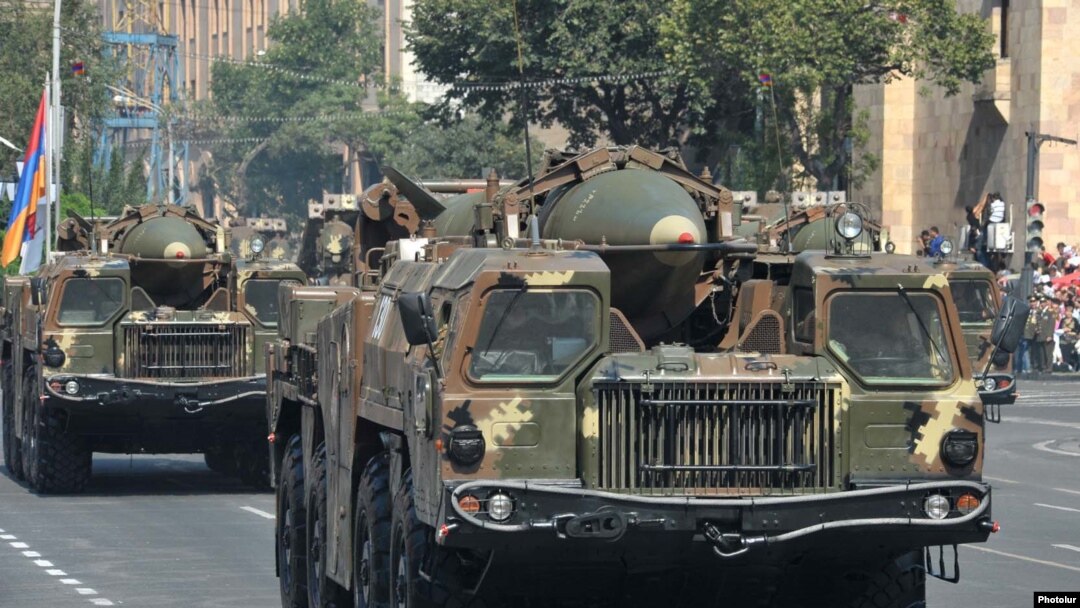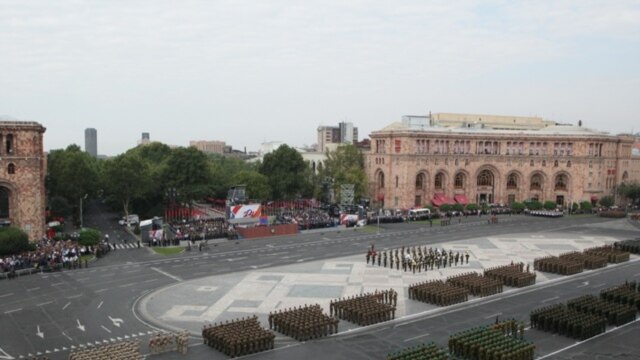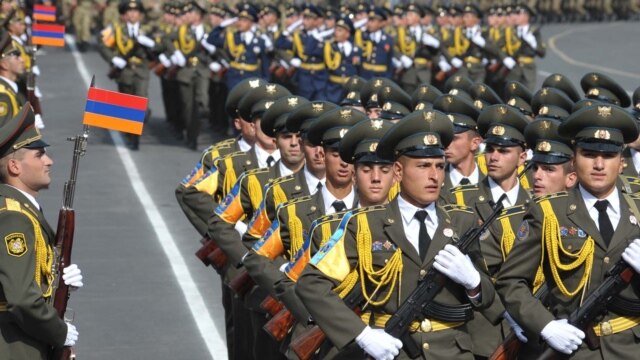Armenia demonstrated for the first time its tactical ballistic missiles, unmanned aircraft and other major weaponry on Wednesday in a military parade in Yerevan that marked the 20th anniversary of its declaration of independence from the Soviet Union.
In what was the biggest display of the country’s military might in five years, scores of troops as well as tanks, artillery systems, warplanes and other military hardware paraded through the city’s main Republic Square.
The parade, watched by Armenia’s political leadership and thousands of ordinary people, was the focal point of official ceremonies dedicated to the September 21, 1991 referendum in which the vast of Armenians voted for independence.
“Today, Armenia, notwithstanding all its problems, is an established state. That is proved by today’s military parade,” President Serzh Sarkisian told the troops lined up in the sprawling square.
“The troops, which will march through this square in ceremonial step, are contemporaries of our independence,” Sarkisian said before soldiers from all five army corps and a commando brigade of Armenia’s Armed Forces marched through the square.
Also taking part in the parade were units from Nagorno-Karabakh’s army, Armenia’s border guard and interior troops as well as the Russian military base headquartered in the country’s second city of Gyumri. More than two dozen warplanes and helicopter gunships roared overhead before a procession of heavy military hardware concluded the parade.
The main highlight of this demonstration was Russian-made 9K72 surface-to-surface ballistic missiles known in the West as Scud-B. The Armenian military was known to have possessed such missiles systems since the late 1990s. But it avoided putting them on display until now.
Designed for the Soviet army in the 1960s, Scud-Bs have a firing range of up to 300 kilometers, putting virtually all strategic facilities in Armenia’s arch-foe Azerbaijan within their reach.
As heavy trucks carrying them rumbled into Republic Square a parade announcer said the missiles have been modernized by Armenian specialists. He said they are now fitted with electronic guidance systems and can destroy enemy targets located “even in densely populated areas.”
The parade also confirmed Armenia’s possession of more short-range but precise Tochka-U ballistic missiles with a NATO reporting name of SS-21 Scarab-B. The Soviet Union developed and began manufacturing them in the late 1980s.
Azerbaijan demonstrated Scarab-Bs during a similar military parade held in June. It also featured Russian S-300 air-defense systems which Baku reportedly purchased from Russia last year.
News of that multimillion-dollar deal raised concerns in Armenia and Karabakh. Opposition groups there said it could seriously limit the Armenian military’s ability to hit strategic targets in Azerbaijan.
Military officials in Yerevan dismiss these concerns, saying that the Armenian side has more such sophisticated systems at its disposal and knows how to “neutralize” them.
Armenia officially admitted having the surface-to-air missiles last December when state television showed official footage of S-300 batteries test-firing missiles in an undisclosed location. S-300s were also paraded in Yerevan on Wednesday.
Defense Minister Seyran Ohanian insisted that Armenia is maintaining “the balance of forces” with Azerbaijan despite the latter’s massive military buildup fuelled by oil revenues. “What matters to us most is not a numerical advantage,” he said. “What matters to us is … qualitative standards ranging from soldiers’ skills to the interoperability of army units and our combat spirit.”
“I think you just saw what kind of armed forces we have,” a visibly satisfied Ohanian told journalists after the parade. “The main thing is that our armed forces were not just created for parades. They manage to prove their capabilities in practice.”
Azerbaijan’s leaders and President Ilham Aliyev in particular regularly threaten to forcibly win back Karabakh and Armenian-controlled territories surrounding the disputed enclave. Their Armenian counterparts insist that Baku will suffer another defeat if it attempts a military solution to the Karabakh dispute.
The Azerbaijani government plans boost military spending to $3.3 billion this year, up from $2.15 a year ago and just $160 million in 2003. By comparison, Armenia’s defense budget for 2011 is projected to reach only $400 million.
Armenia has sought to stay in the intensifying arms race with close military ties with Russia that entitle it to receiving Russian weapons at discount prices or even free of charge. A new Russian-Armenian defense agreement signed in August 2010 commits Moscow to helping Yerevan obtain “modern and compatible weaponry and (special) military hardware.”
The Armenian military also unveiled at the parade other, domestically manufactured weapons, including unmanned military aircraft, flamethrowers and multiple grenade launchers. Military officials say the drones were designed by Armenian engineers.
Your browser doesn’t support HTML5
Կայացավ Անկախության տոնին նվիրված զորահանդեսը




